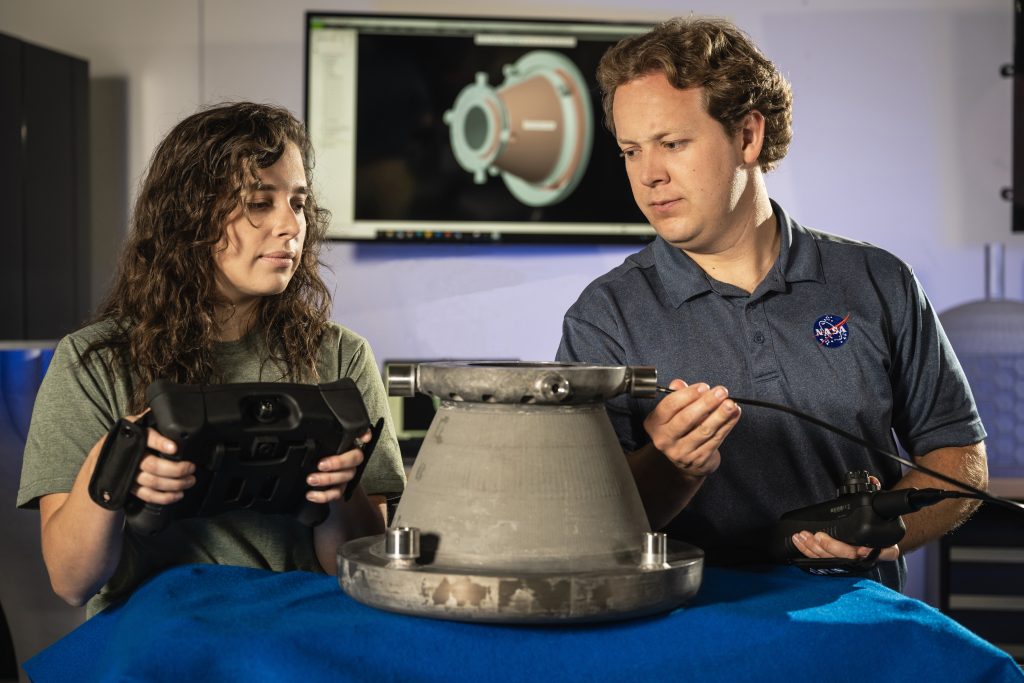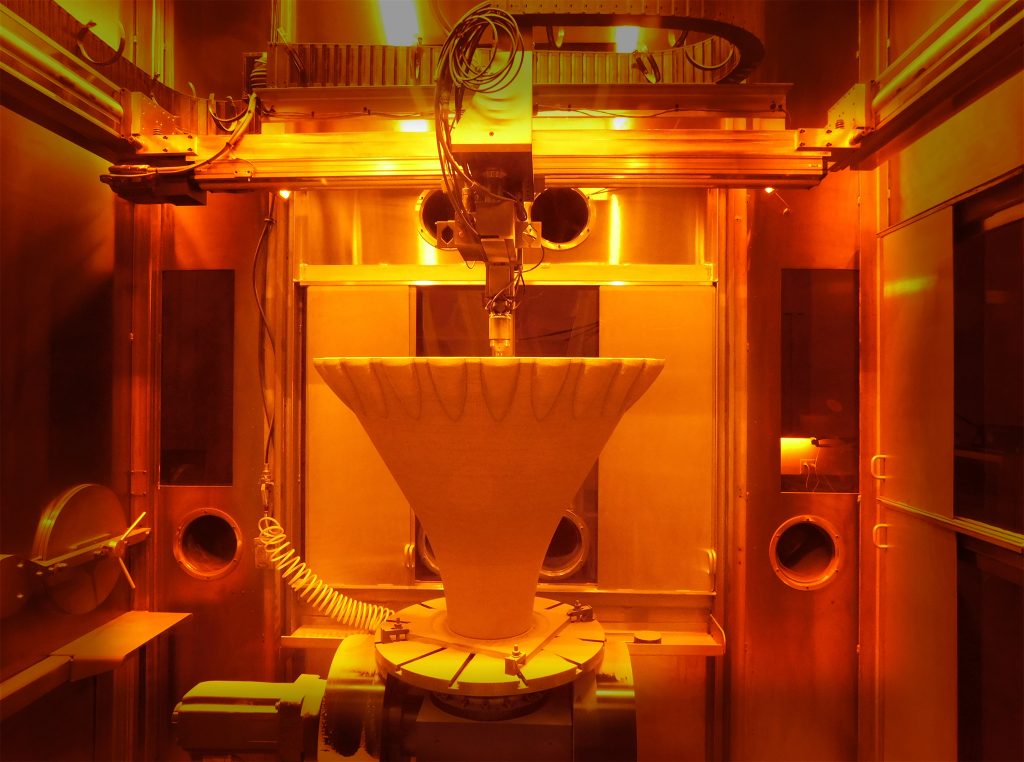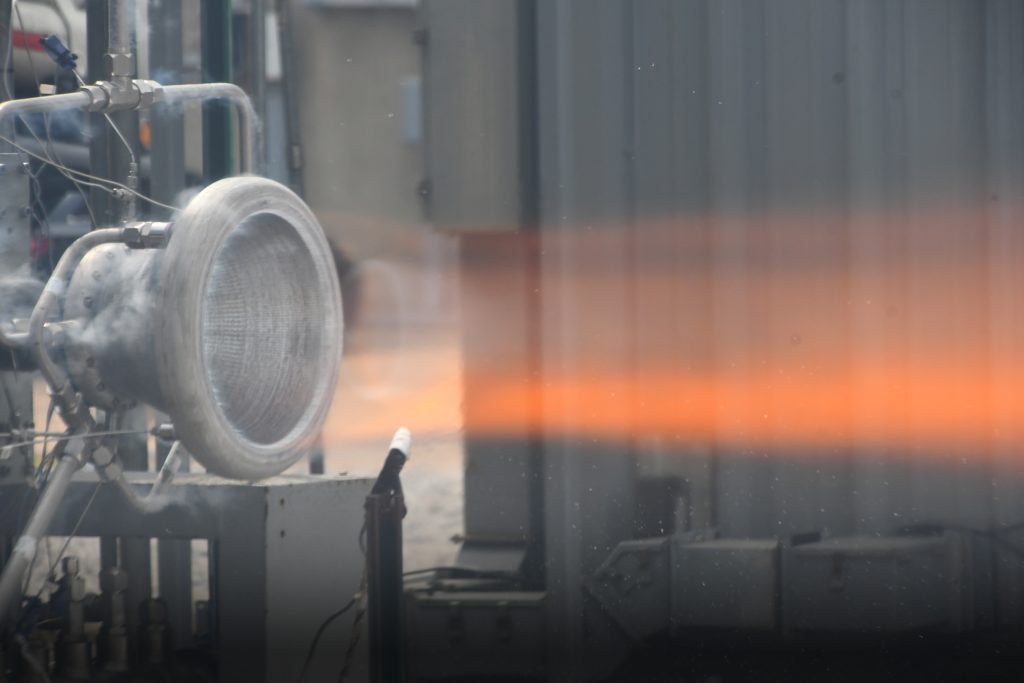NASA, the US National Aeronautics and Space Administration, has successfully 3D printed and tested a new rocket engine nozzle as part of its Reactive Additive Manufacturing for the Fourth Industrial Revolution, or RAMFIRE, project.
NASA engineers from the Huntsville-based Marshall Space Flight Center developed the new RAMFIRE nozzle in collaboration with material developer Elementum 3D. Through this partnership, the team created a weldable aluminum that possesses the required heat resistant properties for use on rocket engines.
Thanks to its low densities, aluminum allows for the production of high-strength, lightweight components. As such, NASA claims that its new 3D printed RAMFIRE rocket engine nozzle is lighter than conventional nozzles, enabling deep space missions that carry heavier payloads.
RAMFIRE is funded by NASA’s Space Technology Mission Directorate (STMD).
“Mass is critical for NASA’s future deep space missions,” explained John Vickers, principal technologist for STMD advanced manufacturing. “Projects like this mature additive manufacturing along with advanced materials, and will help evolve new propulsion systems, in-space manufacturing, and infrastructure needed for NASA’s ambitious missions to the Moon, Mars, and beyond.”

3D printing RAMFIRE rocket engine nozzles
The 3D printed RAMFIRE nozzle incorporates small internal channels, keeping the nozzle cool during operations to prevent melting. Moreover, this new RAMFIRE nozzle is 3D printed as a single piece, minimizing the number of bonds required and significantly reducing manufacturing time. Traditionally manufactured nozzles can require up to 1,000 individually joined parts.
“We’ve reduced the steps involved in the manufacturing process, allowing us to make large-scale engine components as a single build in a matter of days,” commented Paul Gradl, RAMFIRE principal investigator at NASA Marshall Space Flight Center.
NASA and Elementum 3D’s new aluminum variant is known as A6061-RAM2. The two partners also developed specialized powder for use in the laser powder direct energy deposition (LP-DED) process.
To fabricate the nozzles, the RAMFIRE team partnered with directed energy deposition (DED) specialists RPM Innovations (RPMI). RPMI leveraged the newly developed aluminum material and specialized powder to 3D print the RAMFIRE nozzles using their LP-DED technology.
“Industry partnerships with speciality manufacturing vendors aid in advancing the supply base and help make additive manufacturing more accessible for NASA missions and the broader commercial and aerospace industry,” added Gradl.

Targeting deep space missions
NASA’s Moon to Mars initiative seeks to establish a long-term human presence on the moon, followed by human missions to Mars. These missions require the capability to send more cargo to deep space destinations. NASA claims that its new aluminum alloy can play a key role in these missions, by enabling the production of lightweight rocket components that can withstand heavy structural loads.
Two RAMFIRE nozzles have already conducted multiple hot-fire tests at Marshall’s East Test Area. Taking place earlier this year, these tests included oxygen and liquid hydrogen as well as liquid oxygen and liquid methane fuel configurations.
The new nozzles accumulated 22 starts and nearly ten minutes of successful run time. Here, pressure chambers exceeded 825 pounds per square inch (psi), more than the anticipated testing pressures. According to NASA, this testing demonstrates that the 3D printed nozzles can effectively operate in the most demanding deep-space environments.
“This test series marks a significant milestone for the nozzle,” stated Gradl. “After putting the nozzle through the paces of a demanding hot-fire test series, we’ve demonstrated the nozzle can survive the thermal, structural, and pressure loads for a lunar lander scale engine.”
Away from rocket engine nozzles, RAMFIRE aluminum has also been leveraged to additively manufacture other advanced large-scale components for demonstration purposes. This includes a 36-inch diameter aerospike nozzle that combines a complex integral coolant channel with a vacuum-jacketed tank for cryogenic fluid applications.
NASA has also noted that it is sharing data and processes from this project with commercial stakeholders and academia. Consequently, a number of aerospace companies are said to be evaluating the new aluminum alloy and the LP-DED process. The production of satellite components has been touted, among other applications, as a potential use case for the new material.

3D printing rocket engine components
Additive manufacturing is a growing technology for the manufacture of rocket engine components. It was recently announced that AMCM, a Germany-based partner company of 3D printer manufacturer EOS, is developing a new metal Laser Beam Powder Bed Fusion (PBF-LB) 3D printer for space rocket production.
Called the AMCM 8K, this new metal 3D printer will be used to 3D print combustion chambers used in aerospace firm ArianeGroup’s Prometheus rocket engine. Manufactured in CuCr1Zr, these components measure over 1,000 mm in height and possess a maximum diameter of 800 mm.
Elsewhere, Agile Space Industries is working to certify Ni625 powder from industrial 3D printing materials manufacturer 6K Additive. Once certified, Agile will use this material to 3D print critical space rocket parts. In fact, the first parts to be 3D printed using the Ni625 powder will be used in Agile’s A2200 bipropellant hypergolic engine.
“6K Additive allows us to additively manufacture using high-quality powders that are required for our critical applications, while also helping us meet our environmental goals through their recycling program and sustainably manufactured powders,” commented Kyle Metsger, Director of Additive Technology at Agile Space Industries.
Subscribe to the 3D Printing Industry newsletter to keep up to date with the latest 3D printing news. You can also follow us on Twitter, like our Facebook page, and subscribe to the 3D Printing Industry Youtube channel to access more exclusive content.
Are you interested in working in the additive manufacturing industry? Visit 3D Printing Jobs to view a selection of available roles and kickstart your career.
Featured image shows hot fire testing of the 3D printed RAMFIRE nozzle. Photo via NASA.


